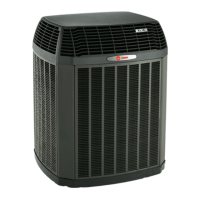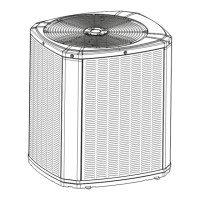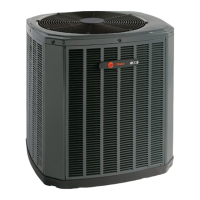Do you have a question about the Trane 4TTV0036B1000A and is the answer not in the manual?
Warning about high voltage risks and lockout/tagout procedures.
Handling R-410A refrigerant, PVE oil, and system sealing requirements.
Warning about hot surfaces, specifically the compressor.
Warning about dangerous DC voltage in electrical components.
Essential earth connection required before electrical supply.
Table detailing model dimensions and estimated weights.
Table showing alternative line sizes and service valve connections.
Guidelines for optimal outdoor unit placement for performance.
Precautions for snow accumulation and freezing conditions.
Requirement for Seacoast Salt Shields in coastal areas.
Instructions for checking unit for damage and removing from pallet.
Criteria for selecting and installing a suitable support pad.
Determining line length and vertical change for charging corrections.
Importance of insulating vapor and liquid lines and contact prevention.
Precautions for using existing lines, brazing, and system checks.
Guidelines for securing lines, preventing noise, and routing through structures.
Method for isolating refrigerant lines within wall cavities.
Sealing and isolating lines passing through walls, avoiding ductwork.
Steps for deburring, cleaning, and purging lines before brazing.
Techniques for brazing lines to service valves and filter driers.
Procedure for pressurizing and checking refrigerant lines for leaks.
Steps for evacuating the system to a specific micron level.
Worksheet and tables for calculating charge for heat pumps.
Worksheet and tables for calculating charge for air conditioners.
Step-by-step guide to safely open the gas service valve.
Cautionary steps for opening the liquid service valve.
Specification for maximum low voltage wire length and size.
Diagrams illustrating low voltage wiring for communicating systems.
Safety precautions and compliance for high voltage power supply.
Requirements for installing a disconnect switch and grounding.
Explanation of Status (Green) and COMM (Amber) LED indicators.
Steps before starting, including thermostat setting and waiting times.
Using the test mode for system charge level adjustment.
Recommended ambient and indoor temperatures for subcooling.
Worksheet for determining final subcooling value using line length and lift.
Table correlating liquid temperature with subcooling and pressures.
Adjusting refrigerant for proper gage pressure using the chart.
Steps for system stabilization and performance verification.
Fields for recording outdoor model, ambient, and line temperatures/pressures.
How to navigate the CDA menus: Monitor, Alert, History, Config, Control.
How demand defrost measures and determines defrost needs.
Steps to initiate and monitor the forced defrost test via CDA.
Comprehensive list of checks for system safety and proper function.
| Model | 4TTV0036B1000A |
|---|---|
| Type | Heat Pump |
| Cooling Capacity | 36000 BTU/H |
| Heating Capacity | 36000 BTU/H |
| SEER Rating | 16 |
| HSPF Rating | 9.0 |
| Refrigerant | R-410A |
| Voltage | 208/230V |
| Phase | 1 |
| Sound Level (Outdoor Unit) | 74 dB |
| Compressor Type | ClimaTuff® Scroll Compressor |












